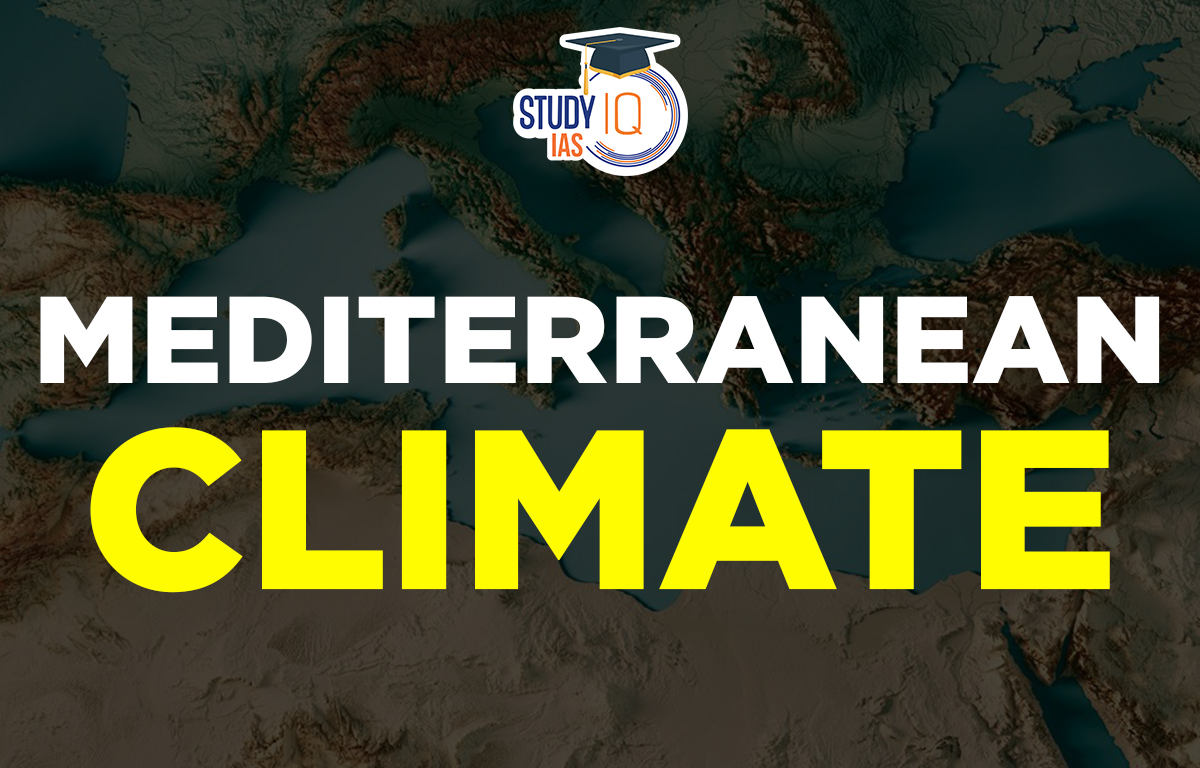Table of Contents
Mediterranean Climate
This climate is mainly found in the western parts of continents between 30° and 45° north and south of the equator. The main reason for this climate is the shifting of wind belts. The Mediterranean Sea has the largest area of this “winter rain climate,” which is why it is called the Mediterranean Climate. The best example of this climate is in central Chile. Other Mediterranean regions include California (near San Francisco), the southwestern tip of Africa (around Cape Town), southern Australia, and southwest Australia (Swanland).
The topic “Mediterranean Climate” is an important part of the UPSC/IAS Exam Geography Syllabus, and it is covered in depth in this article.
Read More: Steppe Climate
Mediterranean Climate Region
This climate has clear skies and high temperatures, with hot, dry summers and cool, wet winters. Average yearly rainfall ranges from 35 to 90 cm. The warmest month sees temperatures of at least 10°C, while the coldest month has temperatures below 18°C but above -3°C. The presence of nearby water bodies helps keep the climate from being too extreme.
Read More: Desert Climate
Mediterranean Climate Distribution Map
The warm temperate western marginal climate is found in some parts of the world. The root cause of this type of weather is the shifting of wind belts. It is characterized by winter rainfall, leading to the so-called Mediterranean climate. Other Mediterranean regions include California (around San Francisco), the southwestern tip of Africa (around Cape Town), South Australia (around southern Victoria and Adelaide, bordering St. Vincent and Spencer Bay), and southwestern Australia. (Swanland).
Read More: Savanna Climate
Mediterranean Rainfall
The Mediterranean lands receive the majority of their precipitation when the Westerlies shift equatorward in the winter. In the northern hemisphere, on-shore Westerlies bring a lot of cyclonic rain from the Atlantic (Typical to Mediterranean Climate). Only a few days a week do heavy showers fall, with brilliant sunny intervals in between. This is another distinguishing feature of the Mediterranean winter rain. Downpours are uncommon, but they are frequently heavy, resulting in devastating floods in mountainous areas.
Read More: Equatorial Climate Regions
Mediterranean Region Winds
A variety of local breezes, some hot and others chilly, are common around the Mediterranean Sea. Two of them are Sirocco and Mistral.
Mediterranean Evergreen Forests
- Open woodlands with evergreen oaks are characteristic of this region.
- These woodlands are found only in the most climatically favorable areas.
- The trees are usually low, often stunted, with thick trunks, small leathery leaves, and extensive root systems for water.
- Cork oaks are especially valued for their thick bark, which is used to make wine bottle corks and exported worldwide.
- In Australia, eucalyptus forests take the place of evergreen oaks, while giant redwoods are typical in California.
Evergreen Coniferous Trees
Evergreen trees with needle-shaped leaves and tall, straight stems, such as pines, firs, cedars, and cypresses, are examples.
Read More: Natural Vegetation of India
Mediterranean Agriculture
Agriculture in the Mediterranean region is well known. Mediterranean agriculture encompasses everything from food crop production to planted crop cultivation such as olives, figs, and dates, as well as fruit and vegetable farming. The most important crop grown in this region is wheat.
1. Orchard Farming
- The Mediterranean lands are known as the world’s orchard lands.
- A variety of citrus fruits, such as oranges, lemons, limes, citrons, and grapefruits, are grown there.
- The fruit trees have long roots to access water deep underground during dry summers.
- The thick, leathery skin of citrus fruits helps prevent excessive water loss.
- The sunny summers allow the fruits to ripen and be harvested effectively.
- Mediterranean regions produce 70% of the world’s citrus fruit exports. The olive tree is a key crop, and olive oil is a valuable cooking oil in this area. Additionally, nut trees like chestnuts, walnuts, hazelnuts, and almonds are also grown for consumption and the chocolate industry.
Read More: Monsoon in India
2. Crop Cultivation and Sheep Rearing
- Wheat is the most important food crop in the region.
- Barley is the second most popular cereal.
- The milder environment of alpine pastures supports some sheep, goats, and cattle.
- Transhumance is a common lifestyle here, involving moving up and down the hills for pastures depending on the seasons.
3. Production of Wine
- Viticulture, or grape growing, is a traditional activity in Mediterranean regions.
- Areas near the Mediterranean Sea produce three-quarters of the world’s wine.
- About 85% of grapes grown are used to make wine.
- The long, sunny summers help grapes ripen well.
Read More: Types of Rainfall
Mediterranean Climate Life and Economy
The region is a net exporter of citrus fruits but imports dairy products. It has clear summer skies and beautiful landscapes, making it a popular destination for tourism, with many Indian songs filmed here. The European Mediterranean is home to many ancient cities and well-known health and leisure resorts that attract millions of visitors throughout the year.
Mediterranean Climate UPSC
Despite the fact that Mediterranean-Climate regions cover less than 2% of the world’s land area, the five regions’ combined vascular plant flora accounts for roughly 20% of all plant species. Furthermore, these Mediterranean-climate zones are widely regarded as some of the most endangered ecosystems on the planet.


 Jallianwala Bagh Massacre, Date, History...
Jallianwala Bagh Massacre, Date, History...
 Important Lakes of India, State wise and...
Important Lakes of India, State wise and...
 Buddhism History, Origin, Sect, Councils...
Buddhism History, Origin, Sect, Councils...





















